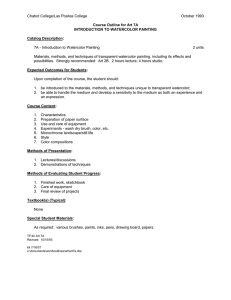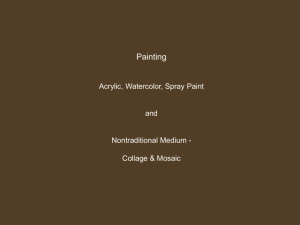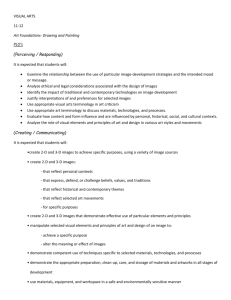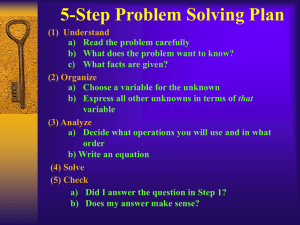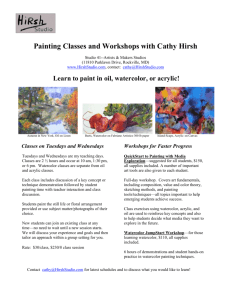S T C
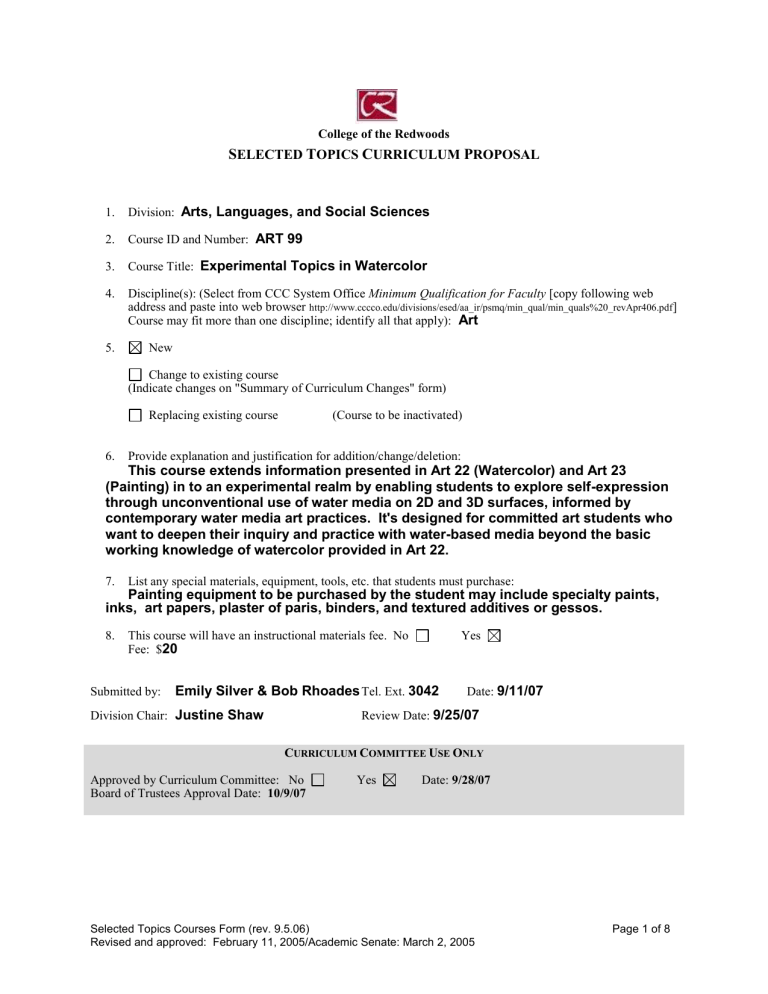
College of the Redwoods
S ELECTED T OPICS C URRICULUM P ROPOSAL
1.
Division: Arts, Languages, and Social Sciences
2.
Course ID and Number: ART 99
3.
Course Title: Experimental Topics in Watercolor
4.
Discipline(s): (Select from CCC System Office Minimum Qualification for Faculty [copy following web address and paste into web browser http://www.cccco.edu/divisions/esed/aa_ir/psmq/min_qual/min_quals%20_revApr406.pdf
]
Course may fit more than one discipline; identify all that apply): Art
5.
New
Change to existing course
(Indicate changes on "Summary of Curriculum Changes" form)
Replacing existing course (Course to be inactivated)
6.
Provide explanation and justification for addition/change/deletion:
This course extends information presented in Art 22 (Watercolor) and Art 23
(Painting) in to an experimental realm by enabling students to explore self-expression through unconventional use of water media on 2D and 3D surfaces, informed by contemporary water media art practices. It's designed for committed art students who want to deepen their inquiry and practice with water-based media beyond the basic working knowledge of watercolor provided in Art 22.
7.
List any special materials, equipment, tools, etc. that students must purchase:
Painting equipment to be purchased by the student may include specialty paints, inks, art papers, plaster of paris, binders, and textured additives or gessos.
8. This course will have an instructional materials fee. No Yes
Fee: $ 20
Submitted by: Emily Silver & Bob Rhoades Tel. Ext. 3042 Date: 9/11/07
Division Chair: Justine Shaw Review Date: 9/25/07
C URRICULUM C OMMITTEE U SE O NLY
Approved by Curriculum Committee: No Yes Date: 9/28/07
Board of Trustees Approval Date: 10/9/07
Selected Topics Courses Form (rev. 9.5.06)
Revised and approved: February 11, 2005/Academic Senate: March 2, 2005
Page 1 of 8
FEATURES
Catalog Description
(Please include text of old catalog description.)
S UMMARY OF C URRICULUM C HANGES
FOR AN E XISTING C OURSE
OLD
Grading Standard Select Select
NEW
Total Units
Lecture Units
Lab Units
Prerequisites
Corequisites
Recommended
Preparation
Maximum Class Size
Repeatability—
Maximum Enrollments
Other
If any of the listed features have been modified in the new proposal, indicate the "old" (current) information and proposed changes.
Selected Topics Courses Form (rev. 9.5.06)
Revised and approved: February 11, 2005/Academic Senate: March 2, 2005
Page 2 of 8
College of the Redwoods
S ELECTED T OPICS C OURSE O UTLINE
DATE: 9/12/07
COURSE ID AND NUMBER: Art 99
FORMER ID AND NUMBER (if previously offered):
COURSE TITLE: Experimental Topics in Watercolor
Is this the first time this course has been offered? The second time? The third time?
FIRST TERM NEW OR REVISED COURSE MAY BE OFFERED:
TOTAL UNITS: 1
TOTAL HOURS: 36
[Lecture Units: .5
[Lecture Hours: 9
MAXIMUM CLASS SIZE:
Lab Units: .5
]
Lab Hours: 27 ]
GRADING STANDARD
Letter Grade Only CR/NC Only Grade-CR/NC Option
Is this course repeatable for additional credit units?
: No Yes how many total enrollments?
DESCRIPTION OF SELECTED TOPIC
Clearly state the scope of the course, its level, and what kinds of student goals the course is designed to fulfill.
A short intensive course for students who wish to expand information presented in Art
22 (Watercolor) and Art 23 (Painting) into an experimental realm. Students will explore unconventional water-based media, including gouache, tempera, watercolor crayons, acrylic ink, and making their own paints . They will experiment with varied techniques and unconventional surfaces (including but not limited to oriental papers, mylar®, and paper mache) informed by contemporary art practices.
PREREQUISITES
No Yes
Rationale for Prerequisite:
Course(s):
Describe representative skills without which the student would be highly unlikely to succeed .
COREQUISITES
No Yes
Rationale for Corequisite:
Course(s):
Selected Topics Courses Form (rev. 9.5.06)
Revised and approved: February 11, 2005/Academic Senate: March 2, 2005
Page 3 of 8
RECOMMENDED PREPARATION
No Yes Course(s):
Rationale for Recommended Preparation:
Art 22
Ability and confidence with watercolor painting and an understanding of their own expressive voice provides a foundation enabling students to more easily begin the process of experimentation in more complex media and media combinations.
COURSE LEARNING OUTCOMES
What should the student be able to do as a result of taking this course? State some of the objectives in terms of specific, measurable student accomplishments .
1. Make artwork using a variety of nontraditional water media including acrylic ink, homemade paint, fresco, egg tempera, watercolor pastels, textured acrylic paint and grounds, paper mache.
2. Experiment and research new media in the context of their personal expression.
3. discuss the strengths and weaknesses of different water-based media and unconventional grounds and preparation of grounds.
4. Develop their individual artistic goals and expressive style through unconventional use of water media.
5. Discuss their paintings as a body of work based upon inquiry into media and their knowledge of the conceptual, thematic, and technical aspects of contemporary art works.
REPRESENTATIVE LEARNING ACTIVITIES
What will students be doing (e.g., listening to lectures, participating in discussions and/or group activities, attending a field trip)? Relate the activities directly to the Course Learning Outcomes.
1. Paint, draw, and make prints water media including, but not limited to watercolor, acrylic ink, gouache, and tempera.
2. Devise and prepare different kinds of grounds for their work, including but not limited to paper mache, wood panel and plaster (fresco).
3. Experiment with water-based media techniques and combinations and keep a record of their results.
4. Ask appropriate questions.
5. Carry on dialogues with classmates related to their experimentation and results
6. Listen to and watch slide lectures about contemporary art and observe technical demonstrations.
ASSESSMENT TASKS
How will students show evidence of achieving the Course Learning Outcomes? Indicate which assessments (if any) are required for all sections .
Representative assessment tasks :
Class critiques and discussions, goal-setting and establishment of benchmarks for success by student
Required assessments for all sections – to include but not limited to :
1. Participation in critiques for every project.
2. Submission of portfolio for final evaluation.
3. One-on-one exit interview with instructor.
COURSE CONTENT
To justify repeatability, describe course content and list texts for two representative selected topics, demonstrating clearly that each will provide significantly different content.
Selected Topics Courses Form (rev. 9.5.06)
Revised and approved: February 11, 2005/Academic Senate: March 2, 2005
Page 4 of 8
Representative Topic #1
Course Title: Watercolor Monoprints
Themes: What themes, if any, are threaded throughout the learning experiences in this course?
1. Knowlegde of basic printmaking planning such as image reversal, color layering, and paper absorbency.
2. Transfer of watercolor painting processes to printmaking.
3. Creative problem-solving and trouble shooting .
4. Making best use of the medium's intrinsic properties.
5. Understanding the relationship between concept, medium, and the communication of complex ideas.
6. Open-minded experimentation.
Concepts: What concepts do students need to understand to demonstrate course outcomes?
1. Basic watercolor painting skills and vocabulary such as making a wash, graded wash, working wet-in-wet, dry-brush painting and bleeds.
2. Basic color theory and color mixing, including but not limited to primary, secondary, tertiary and neutral colors and how to mix them using palette, glazing, and/or bleeds.
3. Concepts and vocabulary of print-making process including monoprint, reversal, transfer, plate, print, brayer, and press, for example.
4. Creating a composition using elements of design such as line, shape, form, texture, pattern, and negative space, among others.
5. Process-based art making.
6. Communication with the viewer.
Issues: What primary issues or problems, if any, must students understand to achieve course outcomes (including such issues as gender, diversity, multi-culturalism, and class)?
1. Historic development of print-making and its role in cultural development.
2. Post-modernist directions such as painting off the campus or quoting historical motif.s
3. Multi-cultural diversity manifested in the contrast between origins, materials, and traditions of western and non-western art, and changes as a result of globalization.
4. Conservation in terms of resource management, recycling, and sustainability of natural resources
5. The effect and inclusion of electronic technologies within regional, national, and global art practices.
6. The dialectic between historical/traditional and contemporary/experimental art practices.
Skills: What skills must students master to demonstrate course outcomes?
1. Listen and follow instructions.
2. Paint and draw confidently with brush, watercolor, and watercolor pastel on paper, plastic, and experimental surfaces.
3. Produce a right-reading watercolor monoprint.
4. Thoughtfully discuss their work with instructors and fellow students using appropriate printmaking and painting vocabulary and historical and contemporary citations.
5. Make evident in their prints an open-minded attitude toward experimentation and an appreciation of the intrinsic qualities and unpredictable results of the watercolor monoprint process.
Selected Topics Courses Form (rev. 9.5.06)
Revised and approved: February 11, 2005/Academic Senate: March 2, 2005
Page 5 of 8
6. Use their art-making as a means of exploring and expressing personal issues, interests, and emotions.
7. Identify the historical, contemporary, and socially and ethnically diverse art forms and practices that inform their art making practice.
Examples of Appropriate Texts or Other Readings : Title, Author, and Date are required .
Author Title Date
Author Title Date
Author Title Date
Author Title Date
Other Appropriate Readings :
A packet of related readings (articles, excerpts from books, instruction sheets, paint and paper information, etc) will be provided.
Representative Topic #2
Course Title: Techniques in Egg Tempera
Themes: What themes, if any, are threaded throughout the learning experiences in this course?
1. Basic elements of egg tempera painting such as ground preparation, paint preparation and application.
2. Egg tempera painting processes such as lakes, glazing, hatching, gold leaf application.
3. Creative problem-solving and trouble shooting.
4. Making best use of the medium's intrinsic properties.
5. Understanding the relationship between concept, medium, and the communication of complex ideas.
6. Open-minded experimentation.
7. Historical traditions and the use of symbolic iconography.
Concepts: What concepts do students need to understand to demonstrate course outcomes?
1. Basic ground preparation and absorbency.
2. Basic egg tempera paint making and proper application( fat on lean).
3. Basic color theory and color mixing, including but not limited to primary, secondary, tertiary and neutral colors and how to mix them.
4. Creating a composition using elements of design such as line, shape, form, texture, pattern, and negative space, among others.
5. Historic traditions as in religious icons and pre Renaissance panel painting
6. Communication with the viewer.
Issues: What primary issues or problems, if any, must students understand to achieve course outcomes (including such issues as gender, diversity, multi-culturalism, and class)?
1. Historic development of egg tempera and its role in cultural development.
2. Compatibilty of materials.
3. Post-modernist directions such as painting off the campus or quoting historical motifs .
4. Multi-cultural diversity manifested in the contrast between origins, materials, and traditions of western and non-western art, and changes as a result of globalization.
Selected Topics Courses Form (rev. 9.5.06)
Revised and approved: February 11, 2005/Academic Senate: March 2, 2005
Page 6 of 8
5. Conservation in terms of preservation of cultural artifacts, archival materials and storage .
6. Iconic symbology past and present.
7. The dialectic between historical/traditional and contemporary/experimental art practices.
Skills: What skills must students master to demonstrate course outcomes?
1. Listen and follow instructions.
2. Properly prepare grounds and make paints for the intended substraits.
3. Paint and draw confidently with brush and egg tempera on various paper, wood and experimental surfaces.
4. Thoughtfully discuss their work with instructors and fellow students using appropriate medium and process vocabulary aas well as historical and contemporary citations.
Examples of Appropriate Texts or Other Readings : Title, Author, and Date are required .
Author Harper Title The Acrylic &Gouache Artists Handbook Date 2007
Author Ramos-Poqui Title The Technique of Icon Painting Date 1991
Author Title Date
Author Title Date
Other Appropriate Readings :
Selected Topics Courses Form (rev. 9.5.06)
Revised and approved: February 11, 2005/Academic Senate: March 2, 2005
Page 7 of 8
FOR VPAA USE ONLY
PROGRAM AND COURSE NUMBER
TECHNICAL INFORMATION
1.
Department: Choose One:
2.
Subject: Course No:
3.
Credit Type: Choose One:
4.
Min/Maximum Units: to variable units
5.
Course Level: Choose One:
6.
Academic Level: UG Undergraduate
7.
Grade Scheme: UG Undergraduate
8.
Short Title:
9.
Long Title:
10.
National ID (CIP):
11.
Local ID (TOPS):
12.
Course Types:
Level One Basic Skills: Choose One:
Level Two Work Experience: Choose One:
Level Three: Placeholder for GE OR
Choose One:
Level Four: If GE : Choose One:
13.
Instructional Method: Choose One:
16.
CoRequisite Course:
17.
CoRequisite Noncourse:
18.
Maximum Class Size:
19.
Repeat/Retake: Choose One:
20.
Count Retakes for Credit: yes no
21.
Only Pass/No Pass: yes no
22.
Allow Pass/No Pass: yes no
23.
VATEA Funded Course: yes no
24.
Accounting Method: Choose One:
25.
Disability Status: Choose One:
26.
Billing Method: T-Term
27.
Billing Period: R-Reporting Term
28.
Billing Credits:
29.
Purpose: Choose One:
30.
Articulation No. (CAN) :
31.
Articulation Seq. (CAN) :
32.
Transfer Status: Choose One:
33.
Equates to another course? course number.
14.
Lec TLUs: Contact Hours:
Lab TLUs: Contact Hours:
Lecture/Lab TLUs: Contact Hours:
15.
Prerequisite:
Particular Comments for Printed Schedule.
.
Selected Topics Courses Form (rev. 9.5.06)
Revised and approved: February 11, 2005/Academic Senate: March 2, 2005
Page 8 of 8
